|
|
|
Published
on 28
May 2010
|
All rights reserved.
|
|
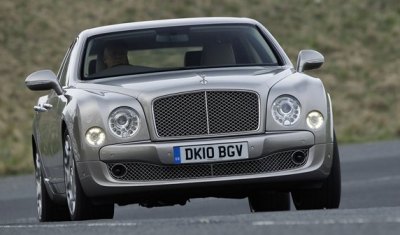 |
First clean-sheet Bentley in 80 years
is challenged by Rolls-Royce Ghost. Which will win the match ?
|
Mulsanne, a familiar name.
It reminisces the first turbocharged Bentley built in the early 1980s.
Mulsanne is also the name of the famous long straight at Le Mans.
Exactly 80 years ago, Bentley won its last and fifth Le Mans title with
its 6½-Litre car (forget the Bentley-disguised Audi which won
the 2003 event). That was the peak of its history. Since then,
it fell victim to the Great Depression and went into the hands of
arch-rival Rolls-Royce. Its cars became badge-engineered and
high-performance versions of Rolls, sadly.
Seven years ago, the two marques were split by Volkswagen and BMW.
Initially, they pointed to different ways – Bentley prospered with
entry-level Continental GT and Flying Spur, while Rolls-Royce was
determined to occupy the most prestigious position with Phantom. This
year, the inevitable thing finally happens: for the first time in 80
years, a Rolls-Royce clashes head on with a Bentley. On right side
corner of the boxing stage is the new Ghost, the first ever
high-performance and driver-oriented Rolls-Royce. At the opposite
corner is Mulsanne, successor to Arnage and arguably the first
clean-sheet Bentley for 80 years. Two boxers, one question: which will
win this match ?
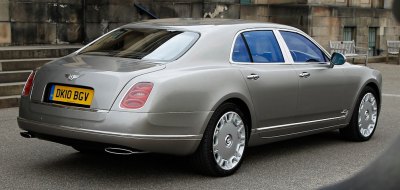
|
If size, weight or torque is what
defines the best British performance luxury, then Mulsanne might stand
a chance...
|
Bentley would have us believed the new Mulsanne competes with Phantom.
If so, it would win easily in performance and driver appeal. However,
the Mulsanne is closer in price (£220,000) to Ghost
(£195,000) than Phantom (£275,000). Moreover, its
performance-oriented character, hence target audiences, is much closer
to the small Rolls-Royce. To the discomfort of Bentley, the Ghost
has an upper hand in performance figures – its twin-turbo V12 produces
60 more horsepower; official 0-60 mph time is 4.7 seconds versus 5.1
seconds; kerb weight undercuts the Bentley's by 225 kilograms. In other
words, the Ghost sounds more Bentley than Bentley.
As the Ghost has already occupied the highland before Mulsanne is
released, the empire's strike-back will never be easy. How to persuade
customers that the Bentley is a better car ?
If size, weight or torque is what defines the best British performance
luxury, then Mulsanne might stand a chance. For a starter, it is huge,
measuring 5.6 meter in length and nearly 3.3 meters between axles. It
tips the scale at 2.6 tons. It rides on 20-inch wheels as standard, but
most customers are likely to opt for the monstrous 21-inch items which
fill better the huge wheel wells.
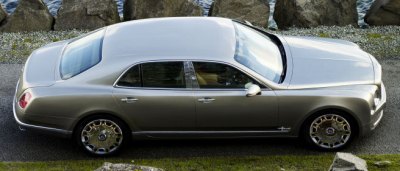
|
Design is a touch old-fashioned... and
looks too much like a big block of butter.
|
The Mulsanne also looks longer and lower than Ghost. It
tries to
appear imposing, but the effort is less successful. Most observers
agree
its exterior design is a touch old-fashioned – especially the sculpted
front fenders, the big round headlamps and the round tail. Retro it
certainly is, it just doesn't interpret traditional
style in modern ways as well as Rolls-Royce. However, the biggest
problem is
its bland proportion, which looks like a big block of butter. If you
disagree, that is only
because it is one of the few designs that look better in photos than in
the fresh.
Nevertheless, the interior is absolutely first class. In contrast to
the modern, minimalist design of Ghost, it retains the traditional
flamboyance of Bentley. Too many switches and gauges might look busy,
but when they are bespoke brushed metal items (unlike some plastic
switches in
Ghost), they can only add to the sense of occasion. The materials and
build quality throughout the cabin is top-notch. There is not a single
piece of plastic present. Everywhere is covered with leather, solid
wood, aluminum or stainless steel. Moreover, you can choose among 9
different wood trims, 9 types of leather, custom stitching and inlays.
In this way, the Mulsanne feels even classier than Ghost.
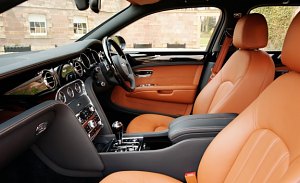
|
Cabin classier and sportier than Rolls
|
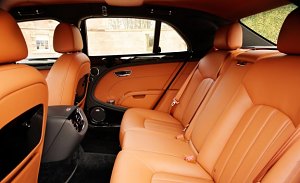 |
|
Bentley says 80 percent of its owners will drive themselves.
They will be delighted to find out front legroom is much improved from
Arnage, and the front seats can finally be set low enough. The soft
leather chair is super comfy. A small-diameter steering wheel with
gearshift paddles hint at its driver-focused character, ditto the
presence of rev counter and a sport / comfort mode control. At the
center
console is an LCD screen for the Audi MMI-based control system. It
would have been better to hide behind a wooden door like Rolls-Royce.
Rear
passengers sit at higher level than the front to have a good view
forward. The rear seats are heated and cooled, recline and incorporate
massagers. Rear seat entertainment system is optional, but individual
climate control is standard.
Now let's go to the technical part. The Mulsanne is built on neither a
Volkswagen
platform nor the previous Arnage platform. It is a bespoke platform
developed specially for this car (and its forthcoming coupe /
convertible
derivatives). If it were developed on a Volkswagen platform, it would
have resulted in all-wheel drive, W12 engine hence vastly different
driving character. The fact that Bentley is the personal favourite of
Ferdinand Piech played an important role in the commitment he made to
the English marque. Considering its sales volume is only 800 units a
year, Volkswagen could have a good reason not to invest into a bespoke
new platform.
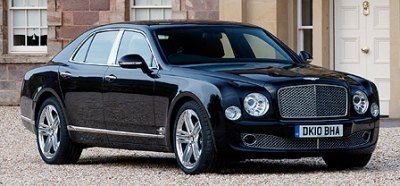
|
Bespoke platform is manufactured at
Crewe
|
So this is Bentley's first new platform in 80 years. It retains the
traditional configuration of rear-wheel drive and a super-torquey
6.75-liter
turbocharged V8. Its chassis is conventional steel monocoque. Doors,
bonnet and front fenders are made of aluminum. Trunk lid is composites
so that not to influence the reception of antenna, which is mounted in
the trunk. Some suspension bits come from Audi, such as control arms,
adaptive air springs and adaptive damping, but you won't tell from the
driving. Most important, this car
is manufactured at Crewe – not just final assembly and trimming, but
the chassis and
their pressings are also made in England.
Open the bonnet, the familiar V8 sits there. Externally, it looks
indistinguishable from the last one serving Arnage. However, it is
essentially a new engine. No matter cylinder heads and block or
internals, all
essential components are new. Yes, it does retain the same bore and
stroke dimensions and the old-fashioned
OHV architecture with only 2 valves per cylinder – which limits its
revvability and top end power, but it introduces variable cam
phasing to the valley-mounted camshaft in order to improve efficiency.
To save gas at part-load running, it adds variable displacement, which
shuts
down valves, cuts injection and ignition in four of the cylinders,
effectively turning the V8 into a V4. In addition to the latest ZF
8-speed automatic transmission, Bentley said its fuel consumption is
reduced by 15 percent from Arnage. At the same time, its output inches
up from 500hp to 512hp, and its world-beating torque is even more
impressive at 752 pound-foot, now available from just 1750 rpm instead
of the previous 3250 rpm.
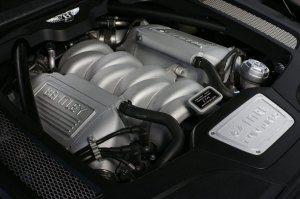
|
Super-torquey V8 is old-fashioned and
very Bentley.
|
That torque dominates its driving manner. In normal driving,
the V8 is near silent, because it hardly needs to spin beyond 1500 rpm,
even when cruising on motorway at 70 mph. The ZF gearchange is almost
undetectable. The superb refinement is just as you would expect on an
ultra-luxury car. However, once you ask for performance, the V8
responds instantly with mountains of torque and a distant growl. So
much torque that you doubt the need of a gearbox, let alone one with
eight ratios. The sensation of instant g-force from very low rev is
noticeably stronger than that of Rolls-Royce Ghost - that car is by no
means short of torque, but its peak value trails the Bentley V8 by 177
pound-foot, and it needs to be revved to better the Bentley. However,
power delivery of the Rolls-Royce V12 is smoother, quieter and more
cultured. It is also more eager to rev than the
Bentley V8. The latter feels more old-fashioned, more brutal when
pushed, or put it this way,
more Bentley.
Despite of its variable displacement and few cylinder count, the
Bentley V8 is considerably thirstier than the Rolls-Royce V12 due to
its inefficient breathing and lack of direct fuel injection. Its
combined fuel consumption is 16.7 mpg, versus the Ghost's 20.8 mpg.
While its rich buyers are unlikely to care about fuel bills, they may
feel uncomfortable with its alarmingly high greenhouse gas emission,
which is 393g per km, versus 317g/km of the Ghost. Admittedly, both
cars are not friends of the earth, but the drivers of RR may feel less
guilty.
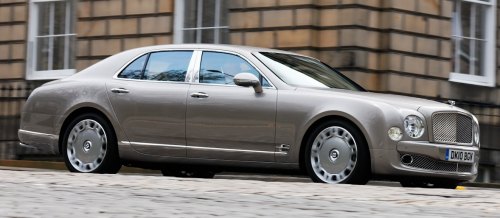
|
| Mulsanne is unquestionably the
sportier car than Ghost... |
Ride and handling continues to distinguish the two cars. The
Mulsanne is unquestionably the sportier car. Its suspension setting is
generally stiffer. Its 21-inch wheels ride on low profile tires
measuring 265/40. In addition to its lower height and lower driver
seat, it displays less body roll in corners and control its big body
more tidily. In the Bentley, you have the choice of Sport, Comfort or
so-called "Bentley" mode for the dynamic control which alters
suspension stiffness and steering weight. To your delight, an
additional Custom mode allows you to preset your preferable settings,
such as Sport steering and Comfort suspension. This makes it more
satisfying to keen drivers than the Rolls-Royce, in which Comfort is
the only mode on offer. On the flip side, the Mulsanne's sporty tires
transmit more road harshness into the cabin. The Ghost rides just like
ghost.
It has to be noted that, although the Mulsanne has sportier handling,
it steering and brake offer less feel than its counterpart.
So there is no loser in the match. Mulsanne and Ghost are apple and
orange. One biases towards driver appeal and one favours refinement,
although they look close on paper. In the end, if you really need to
choose a winner, I would pick the Rolls-Royce, mainly for its tasteful
design, advanced engine and the combination of faster acceleration with
lower emission. The Bentley does have its charm in interior decoration
and driving character, but it feels too old-fashioned for my taste. |
Verdict:     |
| Published
on 5
Dec 2014 |
All rights reserved.
|
|
Mulsanne Speed
|
|
Although a 2685 kg
limousine will never be a sports sedan, it is always good to have more
power. Bentley retuned its 6.75-liter twin-turbo push-rod V8 to produce
an extra 25 horsepower, bringing the total to 530 hp. That might be
peanuts by nowadays’ standard, but more important to Bentley is
probably the increase of 59 pound-foot of torque. At 811 lbft, it
rewrites its own record as the torquest production car in the world.
For reference, the supercharged V8 of Dodge Hellcat models
produces “only” 650 lbft. With the added punch, the heavyweight
Mulsanne Speed can finally sprint from rest to 60 mph under 5 seconds,
while on a long stretch of Autobahn you could see it touching 190 mph.
That’s the territory of supercars a couple of decades ago.
No, the Speed is not as speedy as an S63 AMG or even its lighter, less
costly sister Flying Spur W12. Neither can it come close to the AMG in
terms of handling. Despite of the stiffer setting of its air suspension
(especially in Sport mode) and the weightier tuning of its power
steering, it never quite hides its immense weight and center of gravity
in corners. The steering remains isolated from the road surface, and
the brakes are too weak for committed drives. More satisfying to drive
than the regular Mulsanne? Definitely, but not to the extent of
delighting keen drivers. What it does offer is a unique combination of
lavish luxury, flamboyant style and bespoke interior with a certain
level of performance and control. It pleases a small portion of
super-rich who prefer to skip chauffeurs and drive by themselves. We
thought that was what Bentley used to be. Now the split from Roll-Royce
and the rise of Chinese market has shifted its focus to conventional
super-rich buyers. The Mulsanne Speed is just a small step to bring
back its traditional virtues. Among the 1100 Mulsannes sold annually,
only 300 are expected to be the Speed.
|
Verdict:     |
|
|
|
|
|
|
|
|
|
Mulsanne
|
2010
|
| Front-engined,
RWD |
| Steel monocoque |
Steel + aluminum
|
| 5575 / 1926 / 1521 mm |
| 3266 mm |
V8, 90-degree
|
| 6752 cc |
OHV 16 valves, VVT
|
| Twin-turbo |
| Cylinder deactivation |
512 hp / 4200 rpm
|
752 lbft / 1750 rpm
|
8-speed automatic
|
F: double-wishbone
R: multi-link
|
Adaptive air spring + damping
|
265/40ZR21
|
2585 kg
|
184 mph (c)
|
5.1 (c) / 4.9*
|
11.6 (c) / 12.0*
|
|
Mulsanne Speed
|
2014
|
| Front-engined,
RWD |
| Steel monocoque |
Steel + aluminum
|
| 5575 / 1926 / 1521 mm |
| 3266 mm |
V8, 90-degree
|
| 6752 cc |
OHV 16 valves, VVT
|
| Twin-turbo |
| Cylinder deactivation |
537 hp / 4200 rpm
|
811 lbft / 1750 rpm
|
8-speed automatic
|
F: double-wishbone
R: multi-link
|
Adaptive air spring + damping
|
265/40ZR21
|
2685 kg
|
190 mph (c)
|
4.8 (c) / 5.0**
|
11.1 (c) / 12.7**
|
|
|
|
|
|
|
Performance
tested by: *C&D, **MT
|
|
|
|
|
|
|
|
|
Copyright©
1997-2014
by Mark Wan @ AutoZine
|
|